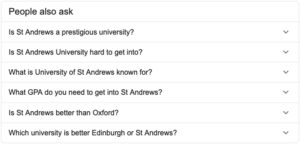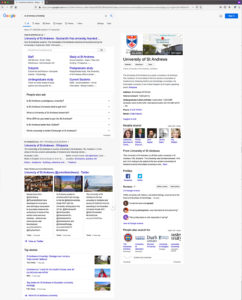Prioritising search results to maximise user engagement
The importance of having the correct web page listed in the top few search results has long been known. However, in some cases only a single result gets the attention of users. This has an impact for the University website both in terms of SEO and also how we maintain and develop our own search service.
In a recent article – The Love-at-First-Sight Gaze Pattern on Search-Results Pages, the Nielsen Norman Group uses eye-tracking studies to identify why 20% of users only ever looked at a single search result.
What factors influence a single result selection
The studies demonstrated a number of different reasons where users only viewed a single result:
Trust in the search engine
Google gullibility, as it is known, is a direct result of the search service consistently providing accurate and relevant search results. When the top result is repeatedly correct why would you continue to check the others?
This trust factor is something that we aim to establish with users of our own search service with the focus on continuous improvement of result quality.
Attractive features
Search engine result pages (SERPs) are no longer just a single list of links, they now contain visually engaging and often interactive elements that change depending on the type of search query. Some of these features such as featured snippets may provide the user with an answer without having to visit the actual page. This could also be helpful for mobile users with poor network connection that may have trouble accessing new web pages.

A sample search for ‘St Andrews University’ on Google included a wide range of different elements including; featured snippets, news articles, tweets, images and a summary of key information with map and directions.

Users have learned to direct their attention to these types of results automatically – so it is important to ensure the quality and relevance of any visually different items are as good as the simple text-based ones.
Low motivation or lack of time
Often users don’t have the opportunity to check multiple search results and will rely on the search engine to highlight the answer. In this situation featured snippets may be used to find the answer immediately without the need to wait for another website to load.
A flaw with this approach was identified in the article, where featured snippets contained information that was not relevant to the context of the search. Without taking the time to verify the information from the source website and only relying on the short snippet of content, the user risks obtaining the wrong result.
The first result meets the exact need
When a user knows exactly what they want and is using the search engine in a targeted way or as a shortcut to navigation then the top result is almost invariably the best one.
How the University’s website search is being used
We analysed anonymous heatmaps and user recordings using HotJar to understand how users interacted with the search results page. This highlighted that the majority of searches selected the top result, with this quickly reducing as you move down the results list.

What the heatmap data doesn’t show is the number of times a same user repeats their search, with different terms, as an alternate strategy to finding a suitable answer. However, a sample of user recordings indicate that the chosen search result was adequate, with no immediate return to the search service after selecting a search result.
Conclusion
While the Nielsen Norman Group article identifies 20% of users as only selecting a single result, a further 41% are shown to interact with the top six results so it’s not yet the dominant behavior.
It is however important that the University website continues to:
- Publish content that is written in plain English and is easy to understand, to help search engines produce featured snippets.
- Use structured data, where possible, to provide search engines with additional context about the content they are crawling.
- Use appropriate titles and headings that are relevant to the content of each individual web page.
- Build trust in our own website search service.
- Develop new features in our own search service to give visually compelling results and instant answers.